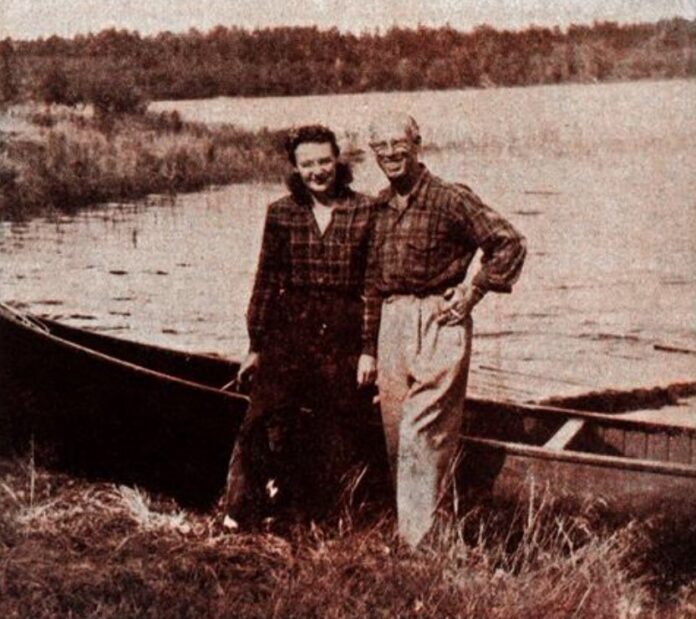The following is the twelfth installment in a series about Nan Dorland, a radio star from New York City who struggled to become a writer and a prospector in northern Saskatchewan. Follow at www.nandorland.blogsot.com or on Instagram @discoveringnan.
“They all said I was crazy,” Richard Morenus begins in his book, Crazy White Man. “When I finally began to agree with them, it was then too late for me to do anything about it. I was seated in a canoe, well past the last outpost of civilization, headed northward toward the bit of insular real estate I had bought, sight unseen, deep in the Canadian bush country. … I was on my own.”
But of course, Richard was not on his own. When he arrived on what is now Winoga Island near Sioux Lookout, Ontario in early May of 1941 he was accompanied by his wife Nan. Together, the couple lived on the island for six years, with Nan proving herself more than capable of surviving in the remote outdoors. There must have been severe strains on the Morenus marriage during these years, for they were divorced in 1947.
Richard omits Nan completely from Crazy White Man, published by Rand McNally in 1952. He may have felt, some would say correctly, that a story of a man surviving alone in northern Ontario for six years made for a more entertaining story, benefiting his book sales. Details like a wife did not fit with his carefully constructed man-against-nature account. It is also possible that, even though Nan had died two years earlier, Richard decided to expunge his former wife from his narrative due to lingering animosity after their divorce. Or perhaps he did not want to upset his new, sixth wife Nora by writing anything about his fifth wife Nan.
After Richard’s split with Nan in 1946, he moved back to the United States and settled down to write Crazy White Man, the first of his six books. On July 27, 1947, the Escanaba Daily News reported that Richard and his “wife” Nora (they were married a year later) were spending the summer at a cottage near Munising, Michigan where he was writing a book on his experiences in Canada.
Crazy White Man received many positive reviews. The Chicago Tribune praised it as “a little classic of the rugged life,” while the Christian Science Monitor called it “one of the best escapes from city pressures.” “Respect for Mr. Morenus’ courage and hardihood grows with every page we read,” Canadian writer Robertson Davies effused in his review in the New York Times.
Richard travelled extensively to promote his book. He became known as a gifted teller of tales of his solo adventure in the wilds of northern Canada. “Morenus is one of those author rarities who is a gifted speaker,” the Eau Claire Leader Telegram enthused. “Audiences like his amusing tales of personal adventure, they chuckle as he directs his humorous barbs at himself and they learn new things about the Canadian bush with its Indians and trappers.”
Morenus’ portrayal of Ontario’s Ojibway people is racist and patronizing throughout Crazy White Man. His use of terminology for Indigenous peoples commonly used in the 1940s and 1950s is jarring to today’s readers – words like “squaw” and “buck” and “savage.” On intermarriage he writes, “No, the lone white man living on an equal basis will not raise the squaw to his level, but the squaw, with passive aboriginal certainty, will inevitably reduce him to hers.” He called the traditions of the Ojibway “superstitions,” saying these were being combated through the “process of evangelizing” in residential schools under the joint control of church and government. He attempted to acquire some understanding of their language which he called a “confusing collection of grunts, groans, wails, and hisses.”
Why are there no photos in Crazy White Man even though Richard and Nan had a camera with them – that they used? First, it would have destroyed the illusion (which it was) that he was alone in the bush. Nan would have either been in the photos or she would have been the photographer. Second, I think Richard destroyed all the photos of their time on the island. Through a series of events, I now possess hundreds of photographs that Richard left behind. There is not a single photo of Nan in the box, nor is there a single photo of the island they lived on together for six years.
“I didn’t get used to the cold, the storms, the blizzards, or the rains,” Richard concludes. “I didn’t get used to the unending struggle against the elements. I didn’t get used to hard physical work. I endured them all, but I didn’t get used to any of them.”
Richard wanted to demonstrate to his readers the struggle and achievement of his six years in northern Ontario. He had persevered through numerous challenges, he tells us, and in the end reached a personal triumph. I for one, however, cannot forget that Nan Dorland shared that triumph with him.
Contact: joanchamp@shaw.ca


